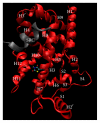Current Advances in the Biochemical and Physiological Aspects of the Treatment of Type 2 Diabetes Mellitus with Thiazolidinediones
- PMID: 27313601
- PMCID: PMC4893583
- DOI: 10.1155/2016/7614270
Current Advances in the Biochemical and Physiological Aspects of the Treatment of Type 2 Diabetes Mellitus with Thiazolidinediones
Abstract
The present review summarizes the current advances in the biochemical and physiological aspects in the treatment of type 2 diabetes mellitus (DM2) with thiazolidinediones (TZDs). DM2 is a metabolic disorder characterized by hyperglycemia, triggering the abnormal activation of physiological pathways such as glucose autooxidation, polyol's pathway, formation of advance glycation end (AGE) products, and glycolysis, leading to the overproduction of reactive oxygen species (ROS) and proinflammatory cytokines, which are responsible for the micro- and macrovascular complications of the disease. The treatment of DM2 has been directed toward the reduction of hyperglycemia using different drugs such as insulin sensitizers, as the case of TZDs, which are able to lower blood glucose levels and circulating triglycerides by binding to the nuclear peroxisome proliferator-activated receptor gamma (PPARγ) as full agonists. When TZDs interact with PPARγ, the receptor regulates the transcription of different genes involved in glucose homeostasis, insulin resistance, and adipogenesis. However, TZDs exhibit some adverse effects such as fluid retention, weight gain, hepatotoxicity, plasma-volume expansion, hemodilution, edema, bone fractures, and congestive heart failure, which limits their use in DM2 patients.
Figures




References
-
- Inzucchi S. E., Bergenstal R. M., Buse J. B., et al. Management of hyperglycemia in type 2 diabetes: a patient-centered approach position statement of the American Diabetes Association (ADA) and the European Association for the Study of Diabetes (EASD) Diabetes Care. 2012;35(6):1364–1379. doi: 10.2337/dc12-0413. - DOI - PMC - PubMed
-
- Qaseem A., Humphrey L. L., Sweet D. E., Starkey M., Shekelle P. Oral pharmacologic treatment of type 2 diabetes mellitus: a clinical practice guideline from the American college of physicians. Annals of Internal Medicine. 2012;156(3):218–231. doi: 10.7326/0003-4819-156-3-201202070-00011. - DOI - PubMed
Publication types
LinkOut - more resources
Full Text Sources
Other Literature Sources

